DIY geothermal heat pump for home heating: device, design, self-assembly
You can organize heating and hot water supply of a private house in various ways, for example, connect to the central gas supply communications or transfer heating systems to electricity consumption. Do you agree?
And you can assemble a geothermal heat pump with your own hands and effectively use the heat of the earth to create comfortable living conditions. Of course, this is a rather time-consuming process, but for those who are at least a little versed in technology, this will not be a big deal.
In our article, we will talk about the principles of operation and types of geothermal installations. We will tell you how to build a heat pump yourself from improvised materials. In addition, in the article you will find expert advice on choosing geo-aggregates. And the videos posted will reveal the secrets of installation and the principles of operation of geothermal pumps.
The content of the article:
How does a thermal geo unit work?
The geothermal heat pump operation algorithm is based on the transfer of heat from a source with a low potential of thermal energy to a heat carrier. The land here plays the role of a radiator in the summer and is an active source of heat in the winter season.
Soil temperature differences help improve overall system efficiency and help reduce actual operating costs.
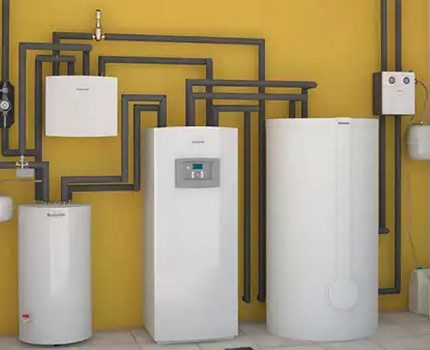
In practice, the existing coolant enters the pipeline located in the ground and is heated there by several degrees. Then the composition goes to the heat exchange unit (or evaporator) and transfers the accumulated thermal energy to the internal system circuit.

The refrigerant operating in the external circuit is heated in the evaporator, converted into gas and enters the compressor. There, it contracts under the influence of high pressure and becomes even hotter.
The hot gas passes into the condensation device and gives off thermal energy to the working coolant of the internal system responsible for heating the house. At the end of the process, the refrigerant that has lost heat returns to its starting point in the liquid state.
What are geothermal installations?
Geothermal heat pumps differ from each other in the type of heat carrier on the internal and external contours of the structure. The energy of the device is obtained from soil, water (groundwater or an open natural reservoir) or air.
Inside the premises, the heat resource is used for heating rooms, heating water and air conditioning. Depending on the combination of elements and functions used, the systems are classified into types: “ground-water”, “water-water” and “air-water”.
Option 1. Land-to-water assembly
The ground-water pump is one of the most effective alternative heating options for residential buildings. The principle of its action is to select with the help of probes or collectors of thermal energy from the soil and transfer it to a home water heating system.
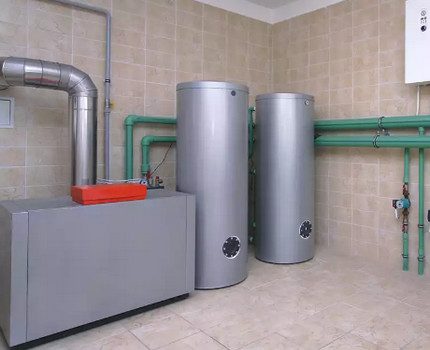
The special installation, consisting of a geothermal heat exchanger located below the depth of the actual freezing of the soil, and the heat pump itself, which functions as a refrigerator, helps to implement the technology, only the other way around (the Carnot reverse cycle).
How the device works
The ground-water installation, which heats the living quarters due to the renewable heat produced by the soil, operates according to the following algorithm:
- The working fluid (brine or antifreeze), moving along the geothermal circuit, takes the temperature of the soil and is transferred to the heat exchanger - evaporator through a pump. There she gives the collected heat to freon, and herself, becoming colder by 2-5 ° C, returns to the starting point.
- Enriched with thermal energy, freon evaporates and, having taken a gaseous state, enters the compressor unit. There, the gas temperature rises due to compression and condensation forms.
- Thermal energy is transferred to the coolant in the home heating system, and freon again takes on a liquid form. Its pressure drops after passing through the expansion valve of the system and the refrigerant is returned back to the evaporator to gain another portion of the resource.
As a result of this procedure, the amount of thermal energy taken from the soil and transferred to the heating system of the residential building is more than 4 times the amount of electricity expended to ensure the correct operation of the compressor unit, the circular pump and the control unit.
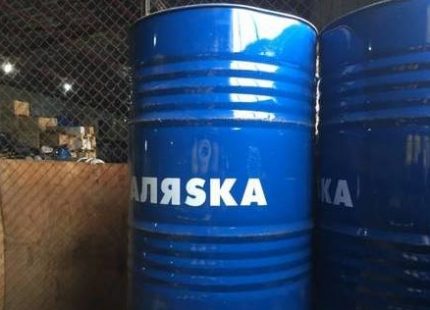
An additional bonus is the fact that the system has the ability to work in the opposite direction, that is, for cooling. True, the loss of efficiency reaches 20%, but this is considered justified, given the high heating ability of the equipment.
Land-to-water placement options
To create the outer contour of the earth-water system, polymer pipes of high strength with good performance characteristics are used. They are placed horizontally, laying on the bottom of the pit in a manner reminiscent of the arrangement of communications for “warm floor” complexes.
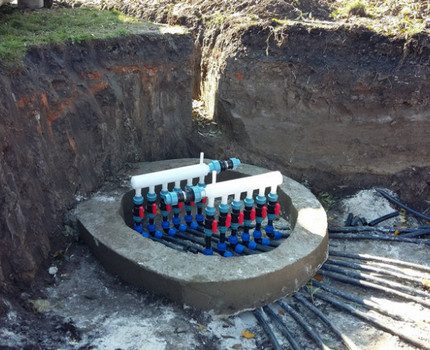
When installing, an area of 25-50 square meters is used. m for each individual kilowatt of power mounted pump. The depth of the pit is chosen below the freezing boundary, and the exact dimensions and the pitch of the pipe laying are determined by an additional calculation.
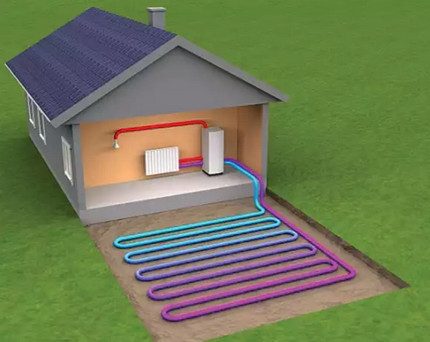
Territories on which communications of geothermal land-water systems are arranged are no longer used for agricultural purposes. They can be broken into a beautiful grassy lawn or flowerbed with blooming annuals.
Vertical installation is much more problematic and entails the use of professional equipment. A well from a depth of 20 to 150 m is drilled at the site using a drilling rig, a special geothermal probe is lowered into it and connected to a pump that supplies the working fluid to the home heating system.
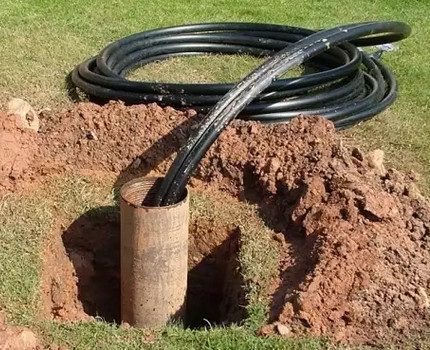
Probe pipes extending from the drilled wells enter the manifold well. From it to the heat pump are 2 main lines (supply and return), equipped with insulation coating. The diameter of the line depends on the total volume of the system and the room that you want to heat. Sometimes the parameters reach 160 mm.
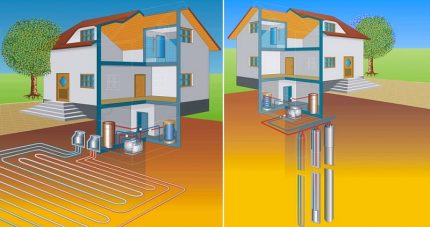
Due to the fact that at a depth the soil temperature is always higher and more stable due to the influence of the earth’s core, the vertical way of laying the heating system is recognized as the most effective. It demonstrates a high level of efficiency and reliably works for many years, without giving failures and breakdowns.
Option # 2. Features of water-to-water heat pumps
The water-water geothermal system uses the thermal energy of a water resource in its work. This is possible because, at great depths, the temperature of the water, like the soil, remains quite high and maintains stable, constant indicators throughout the year.
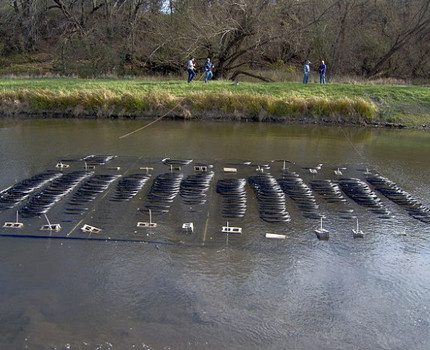
There is no fundamental structural difference between a ground-water heat pump and a water-water heat pump.But the smallest financial and labor costs require a complex equipped on the basis of an open reservoir. Installation does not require large-scale drilling activities.
The pipe material with a coolant is simply equipped with a load, immersed in water and connected to the home heating system through connecting communications.
However, this option is only possible if the land is adjacent to the water and all communication parts of the system are under the control of the owners. If there is no access to an open reservoir, the potential of groundwater is used.
True, this entails serious land work and the construction of complex structures, for example, an additional well, designed to discharge water passing through the heat-exchange unit.
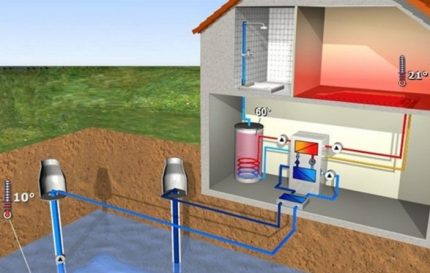
Usually water-to-water installations Mount where there is no way to connect central communications or use other types of coolants.
Experts argue that alternative heating of this type is extremely effective in modern buildings that have a minimum rate of heat loss.
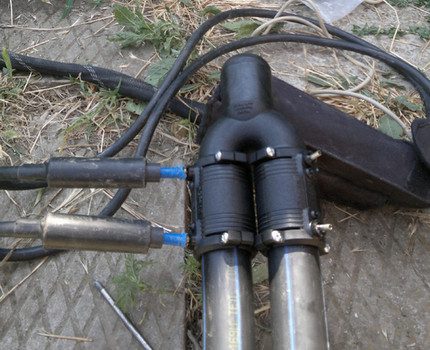
If the house is well insulated, protected from drafts, dampness and the ingress of frosty air, or built using modern thermal insulation technologies, the cost of the heating system is significantly reduced due to the opportunity to purchase pumping equipment of much lower power.
Option # 3. Arrangement of air-water systems
The air-water heat pump uses the most affordable, unlimited and renewable natural energy resource - air for operation. The equipment operates through fans and evaporators, combined into a single complex.
It is most effective at temperatures up to -15 ° C. With more aggressive indicators, it loses a significant part of the power.
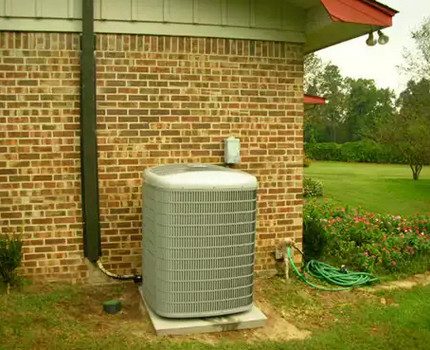
The unit is extremely convenient in that it does not require the owners of a private home to have special equipment for installation and complex installation work.
It does not need excavation, well drilling and other labor-intensive measures. Easy to install and does not take up much space. It can function correctly, located on the roof of the living room.
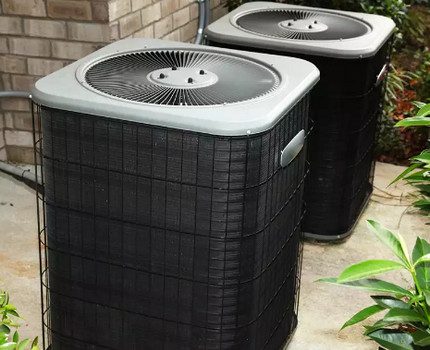
The main advantages of the equipment include almost silent operation and the ability to reuse heat released from the heated room in the form of exhaust air, water, gas, smoke, etc.
The owners carry out system maintenance on their own:
- clean the fan blades and protective grilles on the evaporator installation from dust, small debris and leaves;
- lubricate compressor special composition specified in the manufacturer's instructions;
- change oil in power units (fan, compressor) with a certain frequency;
- check the integrity of the power cable supply and copper piping through which the refrigerant circulates in the system.
In addition to these actions, manufacturers of pumping equipment strongly advise customers to monitor the condition of thermal sensors that reflect the operation of the control unit.
They must be cleaned by gently removing dust and oil stains from the surface. It will extend the “life” withair-to-air systems and will make the operation process more simple and comfortable.
How to make the unit with your own hands?
Regardless of which resource option (earth, water or air) is selected for heating, a pump will be needed for the system to function properly.
This device consists of elements such as:
- compressor unit (intermediate element of the complex);
- evaporatortransmitting low potential energy to the coolant;
- throttle valvethrough which the refrigerant finds the return path to the evaporator;
- capacitorwhere freon gives off thermal energy and cools to the original temperature.
You can purchase a complete system from the manufacturer, but it will cost a decent amount. When there is no free money at hand, you should make a heat pump with your own hands from the available parts and, if necessary, buy the missing parts.
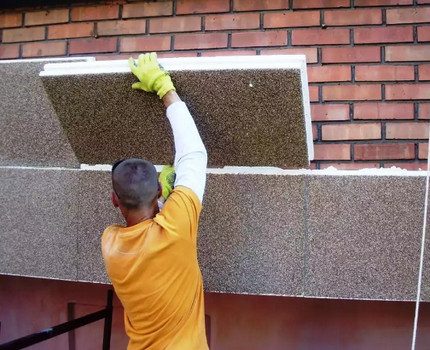
When the decision to make a heat pump with your own hands is made, you must definitely check the condition of the electrical wiring and electric meter available in the house.
If these elements are worn and old, it is necessary to look at all the areas, detect possible malfunctions and eliminate them before starting work. Then the system immediately after startup will work flawlessly and will not disturb the owners with short circuits, fire wiring and knocking out traffic jams.
Method # 1. Assembly from the refrigerator
To assemble the heat pump with your own hands, remove the coil located at the back of the old refrigerator. This part is used as a capacitor and placed in a high-strength container that is resistant to aggressive temperatures. A properly working compressor is attached to it, and a simple plastic barrel is used as an evaporator.
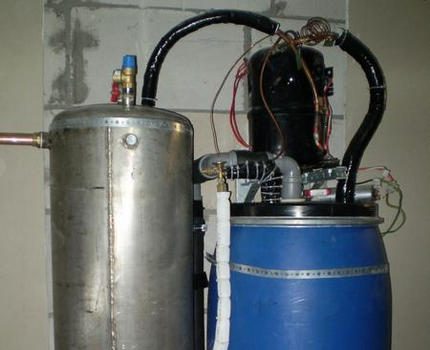
The prepared elements are interconnected, and then the created unit is connected to the heating system by means of polymer pipes and the equipment is put into operation.
A step-by-step instruction on how to assemble a heat pump from a refrigerator is described in this article.
Method # 2. Air conditioning heat pump
In order to make a heat pump, the air conditioner is modified and some basic units are redeveloped. First, the outer and inner blocks are interchanged.
The evaporator, which is responsible for the transfer of low-grade heat, is not additionally installed, since it is available in the indoor unit of the unit, and the heat-transferring condenser is located in the outdoor unit. Both air and water are suitable as a heat carrier.
If this installation option is not convenient, the condenser is installed in a separate tank designed for the correct heat exchange between the heating resource and the coolant.
The system itself is equipped with a four-way valve.A specialist with professional skills and experience in conducting events of this kind is usually invited for this work.
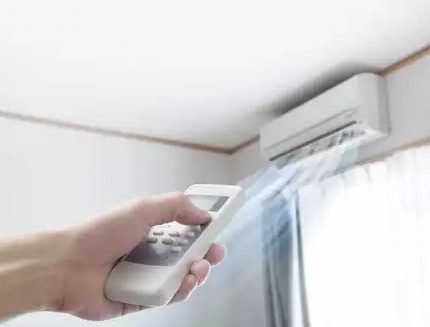
In the third version, the air conditioner is completely disassembled into its constituent parts, and then the pump is completed from them according to the traditional generally accepted scheme: evaporator, compressor, condenser. The finished device is connected to the equipment heating the house and begin to use.
The site has a series of articles on the manufacture of heat pumps with their own hands, we recommend that you read:
- How to make a heat pump for home heating yourself: the principle of operation and assembly diagram
- How to make an air-water heat pump: device diagrams and self-assembly
System Tips
Installation of land-water equipment is more expensive than all other options, because it requires deep excavation work with a vertical arrangement of equipment or a large free area of a site with horizontal laying of communications.
These parameters limit the use of the system and significantly reduce its attractiveness.
Installing a water-to-water pump also has some limitations. If there is an accessible body of water nearby, you can place the system in it. The lack of open water will entail the drilling of wells and bypass wells, which is also not cheap.
The air-water pump does not present installation problems, and can work correctly even in apartment buildings, but in severe winters with low temperature indicators its efficiency decreases and a parallel energy source is required to support it.
However, arrangement of geothermal heating as a result, it pays off its costs and begins to develop a free resource, allowing owners to live in the most convenient, pleasant and comfortable conditions, without spending a lot of money on utility bills.
Conclusions and useful video on the topic
The video illustrates how a heating system based on geothermal air-water heating equipment is equipped in a large house from a gas-silicate block. Some interesting nuances regarding the installation of equipment are disclosed and the real numbers of utility bills for the month are announced.
How does ground-water equipment work? A detailed description from a specialist in the installation of geothermal thermal boilers, recommendations and useful tips for home masters from a professional in their field.
A real user of equipment shares his impressions of the thermal geothermal pump.
A professional locksmith tells how to make a heat pump at home based on a powerful compressor and tubular heat exchange parts. Detailed step-by-step instructions.
A geothermal pump for heating a private home is a good way to create comfortable living conditions even where centralized communication systems and more familiar sources of energy are not available.
The choice of system depends on the territorial location of the property and the financial capabilities of the owners.
Have experience manufacturing a geothermal heat pump? Please share information with our readers, suggest your version of the assembly. You can leave comments and attach photos of your homemade products in the form below.

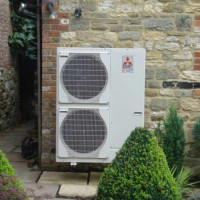 How to make a heat pump for heating a house with your own hands: the principle of operation and assembly scheme
How to make a heat pump for heating a house with your own hands: the principle of operation and assembly scheme 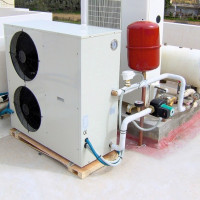 How to make an air-water heat pump: device diagrams and self-assembly
How to make an air-water heat pump: device diagrams and self-assembly 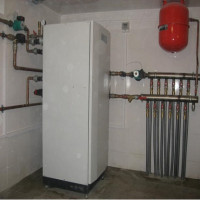 How to make a heat pump with your own hands from an old refrigerator: drawings, instructions and assembly tips
How to make a heat pump with your own hands from an old refrigerator: drawings, instructions and assembly tips 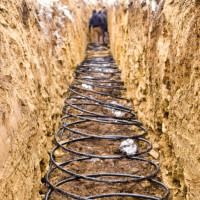 Geothermal heating systems of a country house: features of making it yourself
Geothermal heating systems of a country house: features of making it yourself 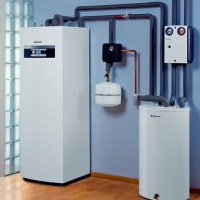 Water-water heat pump: device, principle of operation, rules for arranging heating on its basis
Water-water heat pump: device, principle of operation, rules for arranging heating on its basis 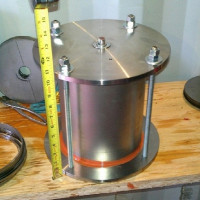 Frenett heat pump: device and principle of operation + can you assemble it yourself?
Frenett heat pump: device and principle of operation + can you assemble it yourself?  How much does it cost to connect gas to a private house: the price of organizing gas supply
How much does it cost to connect gas to a private house: the price of organizing gas supply  The best washing machines with dryer: model rating and customer tips
The best washing machines with dryer: model rating and customer tips  What is the color temperature of light and the nuances of choosing the temperature of the lamps to suit your needs
What is the color temperature of light and the nuances of choosing the temperature of the lamps to suit your needs  Replacement of a geyser in an apartment: replacement paperwork + basic norms and requirements
Replacement of a geyser in an apartment: replacement paperwork + basic norms and requirements
Our people are not yet ready for a geothermal heat source of energy. It seems to me that all sorts of facilities associated with similar methods of generating energy find their application in Europe, where people have long learned to save. And we are far from this. Such technologies, unfortunately, are too laborious, it is much easier to connect to the gas pipeline. And even more so try to do it yourself. No, this is not for us yet. Here at least to learn how to use solar panels.
But I do not agree with the previous comment. What does it mean: “our people are not ready for such a source of energy”? If no one tries to use it, then we will never be ready for anything. Things like that don't happen on their own. Personally, I am going to equip the water-to-air system and am sure of success. I understand the topic well and I'm not afraid to try something new.
I fundamentally disagree with the first comment. Alexander, apparently, does not think that in Russia beyond the Urals it will be problematic to connect to the gas pipeline, because all gas pipelines lead to the very Europe where they have long learned to save. Given the annual increase in coal and firewood prices, it’s time to seriously think about installing a heat pump.
Alexei, we learned in Europe also because there governments actively support energy-saving technologies. For example, interest-free loans for the purchase of such equipment. Well, propaganda is universal, in the positive sense of the word.
There is no need to nod to Europe. How much gas is there? How much does it cost? energy? How much coal is there? And more ... and what is their monthly income level in terms of rubles? From here everything follows.
Here is an example of Mr. Uglich. The cost of kW of thermal energy: birch firewood - 2.28 rubles, natural gas - 0.63 rubles, liquefied - 2.02 rubles, coal of grade D - 1.11 rubles, light pellets - 1.72 rubles. geothermal heat pump (with the delivery of 1 kW of electric energy - by 4.5 kW of heat) - 1.51 rubles. And taking into account the cost of work and the heat pump ... the costs will not be repelled even after 10 years. And a guarantee of 15 years is not needed ... think for yourself, but will these firms (supplier or contractor) exist in 5-10-15 years? In our economy, this guarantee is more like a zilch.
I mean, you can give guarantees for 100 years 🙂 There is only one conclusion. Pull natural gas towards your home. Well, while pulling (the process is sometimes not quick), then put the automatic coal boiler.